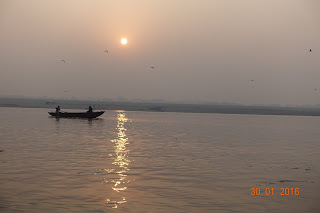Rishikesh is a magnet for spiritual seekers, mainly Hindus. Today it styles itself as the "Yoga Capital of the World". The Ganges is fast flowing at this point, with two foot bridges to cross by. Forested hills surround the town, with a raw wind blowing down through the valley. Pilgrims and tourists mix easily. Orange clothing is the most predominant colour, being worn by sadhus, holy men and con artists. A regular here for over 30 years told me that about 1 in a 100 is genuine. Beggars obtain money from the pilgrims. Westerners have a choice of over 30 styles of yoga, teacher training and practice, including Hasya Yoga (laughing yoga), crystal healing, humming and many other new age things. The town has grown significantly since my last visit on that memorable day, "9/11". White water rafting, hiking and the gateway to treks in the Himalayas are now just someof the further attractions. Ashrams, restaurants, religious items and warm woollen clothes, made mainly by Nepalese, crowd the traffic free street to other temples. A procession of people pass by all day. I enjoy just sitting at a cafe, with a masala tea, people watching. There are so many slim, fit looking women striding to and fro to their yoga, with a sticky mat under their arm, dressed in baggy colourful clothes, a shawl over their shoulder and maybe some beads too. It is a place of smiles and "namaste" greetings. Most visitors buy a shawl to keep warm in the chilly evenings, the sun at altitude during the day is most penetrating. Thick hand knitted beanies and socks in yak wool, which help to maintain body temperature at sunset. Temples and ghats are where you see religion in operation. Colourful ganga aarti, the floating of little lights twinkling on the river at night. Here I had the most comfortable bed that I have slept in during my 3+ months in India.
A display of Madhubani Art originals, which often use eye catching geometrical patterns, and religious symbolism. Natural dyes and pigments are used, twigs, fingers, matchsticks are used to apply the paints. In 1934 a British colonial official "discovered" some paintings on mud walls after an earthquake. In fact the art form had been lay in the hands and skills of poor villagers for over 1,000 years. This art enthusiast recognised their similarity to the works of Picasso and Jean Miro. Traditionaly they are done by poor women in Bihar State and Nepal. I bought two. One of the reasons I visit India so frequently is its arts and crafts, which are so different to the highly "monetized" western art.
A line of beggars who obtain a living from pilgrims
One of the two footbridges over the Ganges
Beads for tourists
Some of the yoga trainings on offer at justone school
Street of shops, cafes, pilgrims and travellers
A "sizzler" of steamed and roast vegetables, £1.50!
Moneys look cute, but they are a pest at all religious places, snatching food and bags. I met a person who had their phone taken, but managed to recover it. No solar panels as they break them. They raid unexpectedly when relaxing on a roof top.
I cannot ignore a bookshop
A view across the footbridge to two temples.
Riverside buildings
A peaceful ashram courtyard

































































